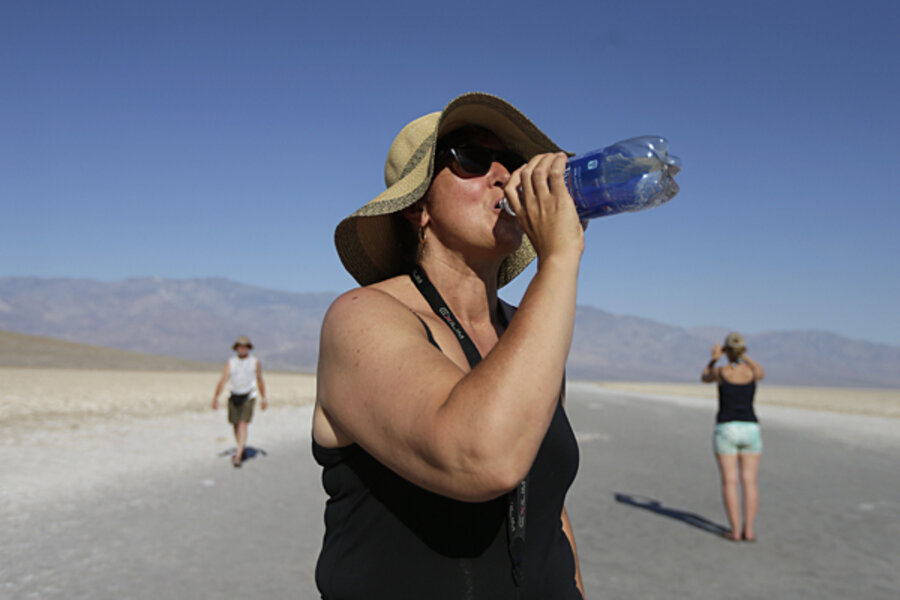Heat wave tests California power grid. Why no blackouts so far?
Loading...
An oppressive heat wave strained California power plants through the weekend and into Monday, as overheated residents blasted fans and air conditioning to keep cool in record temperatures.
It's the grid's first major test of summer's spiking energy demand, and so far it seems to be passing. Improved grid technology and better communication of energy use have helped prevent any major blackouts so far. But the permanent closing of one major nuclear plant last month and the temporary shutdown of another last week further complicates the stress of summer's high temperatures, and utilities remain on high alert.
"Over time they’ve added transmisson to the grid," Jeff Roark, senior project manager at Electric Power Research Institute, said in a telephone interview, "as well as technology that provides info on what’s happening on the grid. Those devices are providing new information of the type that utilities didn’t have before."
The improved information technology is helping customers as well. Utilities can now provide realtime demand information to consumers online and send out alerts via mobile phones and social media. That helps spread the call for efficiency during times of peak demand.
Utilities in California, Nevada, Arizona, and elsewhere out West were on high alert throughout the weekend – asking customers to implement power-saving measures and prepare in case of an outage.
The California Independent System Operator, which controls most of the state's power grid, issued a so-called "flex alert" across northern California for Monday and Tuesday. Consumers should reduce their energy use between noon and 7 p.m., when demand for air conditioning is at its highest.
Utilities recommend turning off unnecessary lights, postponing major appliance use until after 6 p.m., and turning air conditioners up to 78 degrees, or using a fan instead. Those cutbacks can generate savings of 1,000 megawatts statewide, enough electricity to power 1 million households, according to the California Independent System Operator.
"Some of these generators have been running at full speed for many hours now and they're not designed to do that and they break," Steven Greenlee, spokesman for the California Independent System Operator, told USA Today Sunday. "We could be looking at setting a season peak through this heat wave. It would be a very early one at that. Usually our peaks are in August."
Last Wednesday, a leak forced California power company PG&E Corp. to shut down a 1,122 megawatt unit at its Diablo Canyon nuclear power plant at Avila Beach, Calif. It's the state's only remaining nuclear power plant since the San Onofre Nuclear Generating Station shut down for good in early June. The San Onofre plant had not generated electricity since January 2012 after a small radiation leak led to the discovery of damaged tubes that carry radioactive water. A tangle of investigations and regulatory uncertainty dashed Southern California Edison's (SCE) plans to one day bring the plant back online.
"SCE is taking measures to make up for critical power generation resources that will not be available this year with the retirement of the San Onofre nuclear plant," SCE spokeswoman Vanessa McGrady told the Los Angeles Daily News in the lead up to the heat wave last week. "SCE continues to make critical infrastructure improvements to its transmission systems and is bringing online 1,900 megawatts of generation – enough to power 1.23 million homes at a point in time – from Walnut Creek Energy Park in the City of Industry, the CPV Sentinel Energy Project in the Coachella Valley and the El Segundo Generating Station."
Demand hovered around 38,848 megawatts early Monday afternoon and is projected to peak at 48,300 megawatts by late afternoon. Tuesday's peak demand is projected slightly lower at 47,808 megawatts.
A high pressure system Friday brought the heat to the West. Temperatures peaked Sunday in Death Valley National Park, where the National Weather Service's thermometer recorded 128 degrees F. That ties the record for the hottest June day anywhere in the country.








